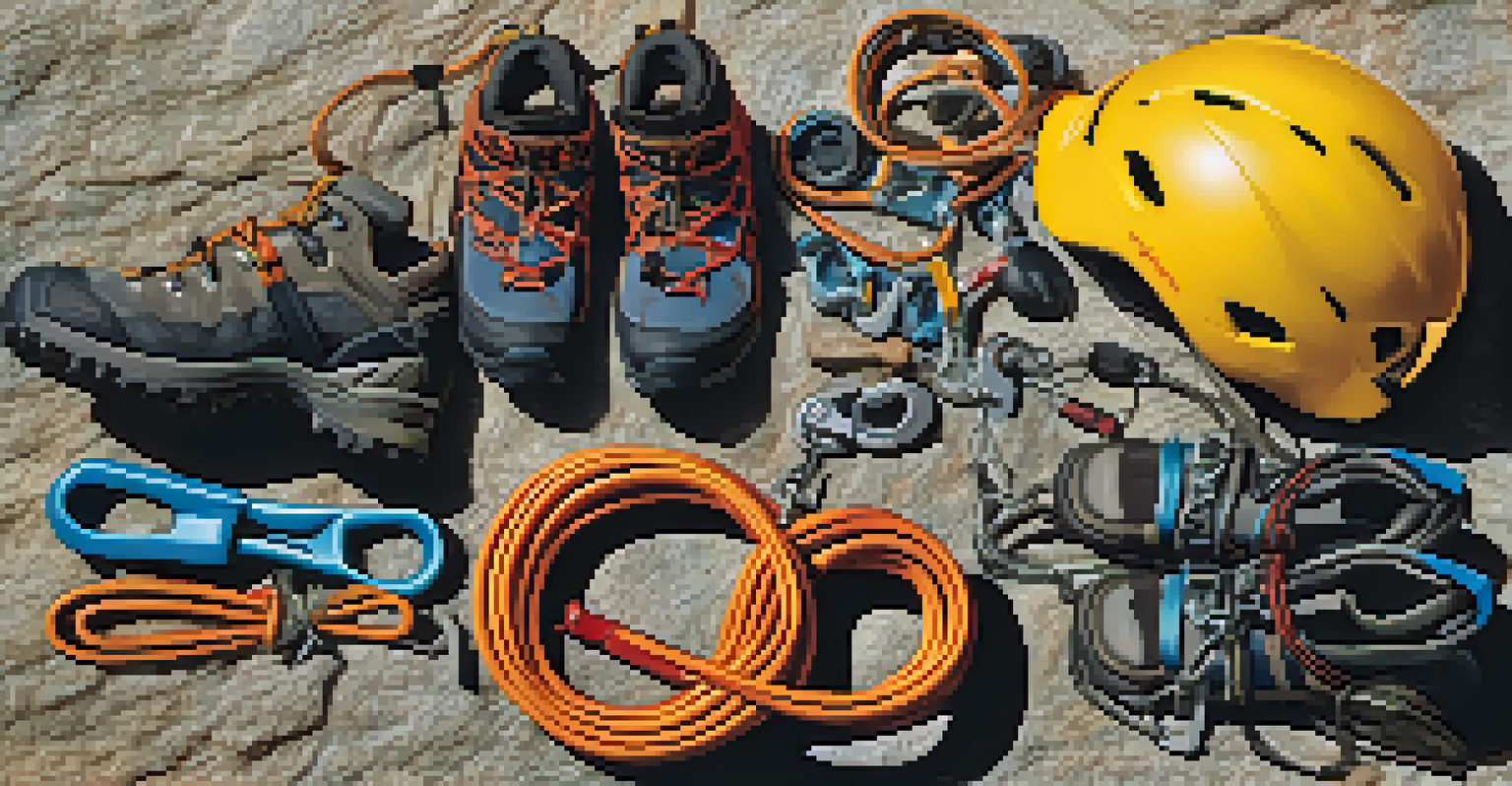Mountain Climbing: Preparing for Your First Summit

Understanding the Basics of Mountain Climbing
Before you lace up your boots, it’s crucial to grasp what mountain climbing entails. This sport isn't just about physical strength; it also requires mental resilience and knowledge of the terrain. From hiking to technical climbing, there are various styles that cater to different skill levels and preferences.
The mountains are calling and I must go.
Consider starting with a basic hike to build your endurance and familiarize yourself with the outdoors. As you gain experience, you'll learn about the equipment, techniques, and safety measures necessary for more challenging climbs. Understanding these basics sets a solid foundation for your climbing journey.
Remember, every climber started somewhere. Embrace the learning process, and don't hesitate to ask experienced climbers for tips or advice. This sense of community can be incredibly beneficial as you embark on your climbing adventure.
Essential Gear for Your Climbing Adventure
Having the right gear is key to a successful and safe climbing experience. Start with a sturdy pair of climbing shoes, which provide the grip and support you need on rocky surfaces. Don’t forget a comfortable harness, a helmet for safety, and a reliable backpack to carry your essentials.

Additionally, consider investing in climbing ropes, carabiners, and quickdraws as you progress. These items not only enhance your safety but also improve your climbing efficiency. For your first summit, a simple daypack with water, snacks, and a first-aid kit will suffice.
Mastering Climbing Basics
Understanding the fundamentals of mountain climbing, including techniques and safety, is essential for a successful start.
As you gather your gear, try to talk to other climbers or visit a local outdoor shop. They can provide invaluable insights into what equipment is best for your specific climbing goals. Remember, quality gear can make all the difference.
Choosing the Right Climbing Route
Selecting a suitable climbing route is an essential part of your preparation. When you’re new to climbing, opt for beginner-friendly trails that allow you to build your skills gradually. Research local climbing areas or seek recommendations from experienced climbers to find the best routes.
Climbing is as close as we can come to flying.
It's also wise to check the route's difficulty level and gauge your current fitness and skill. Websites and guidebooks often categorize routes based on their challenges, which can help you pick one that aligns with your abilities. Remember, there's no rush—it's about enjoying the journey.
As you gain confidence, you can start exploring more challenging routes. Take notes on what you learn from each climb, as this will help you make informed decisions in the future. Embrace the adventure and let each climb teach you something new!
Training Your Body for Climbing Challenges
Climbing can be physically demanding, so proper training is essential. Focus on building your strength, endurance, and flexibility through a mix of cardio, strength training, and stretching exercises. Activities like running, swimming, or cycling can enhance your overall fitness.
Incorporate climbing-specific workouts into your routine, such as pull-ups, core exercises, and leg workouts. These exercises will not only prepare your body but also help prevent injuries. Consistency is key—make a training schedule that allows you to gradually increase your intensity.
Importance of Proper Gear
Having the right climbing gear not only enhances safety but also improves your overall climbing experience.
Lastly, don’t forget about rest and recovery. Your body needs time to adapt to the training, so include rest days in your regimen. Listening to your body will ensure you’re in peak condition when it’s time to tackle your first summit.
Understanding the Importance of Safety Measures
Safety should always be your top priority while climbing. Familiarize yourself with essential safety protocols, such as using proper knots and knowing how to belay effectively if you're climbing with a partner. Always check your gear before starting a climb.
Moreover, it's crucial to assess the weather conditions and be aware of your climbing environment. Sudden weather changes can pose serious risks, so always have a contingency plan. Carrying a map and a compass can be lifesaving if you lose your way.
Lastly, communicate your plans with someone who isn’t climbing with you. Let them know where you’re going and when you expect to return. This simple step can ensure help is on the way if something goes wrong.
Nutrition and Hydration for Peak Performance
What you eat and drink before and during your climb can significantly impact your performance. Prioritize a balanced diet rich in carbohydrates, proteins, and healthy fats in the days leading up to your climb. Foods like whole grains, fruits, and lean meats can provide the energy you need.
During your climb, stay hydrated by drinking water regularly. Dehydration can lead to fatigue and decreased performance, so keep a water bottle handy. Energy bars or trail mix can also provide quick fuel when you need a boost.
Safety and Nutrition Essentials
Prioritizing safety measures and maintaining proper nutrition and hydration are crucial for peak performance during climbs.
Post-climb, refuel your body with a nutritious meal that includes protein and carbohydrates. This will help in recovery and prepare you for your next adventure. Remember, proper nutrition and hydration are vital components of your climbing journey.
Building Mental Resilience for Climbing Success
Mountain climbing is as much a mental challenge as it is a physical one. Developing mental resilience can make a significant difference in your climbing experience. Techniques such as visualization and positive self-talk can help you overcome fears and stay motivated.
Before your climb, take time to visualize yourself successfully reaching the summit, focusing on the steps you'll take to achieve that goal. This mindset can boost your confidence and help you tackle obstacles more effectively.

Lastly, embrace the journey, with all its highs and lows. Each climb will teach you valuable lessons, so be patient with yourself and celebrate your progress. Building mental resilience takes time, but it will serve you well in climbing and beyond.